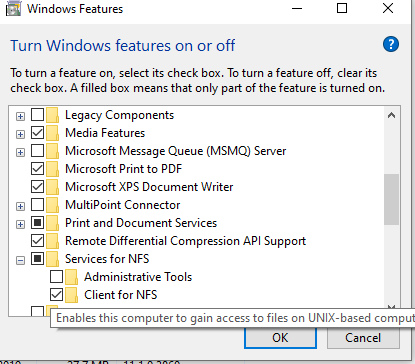Steps below are showing how to mount a NFS share on Windows client.
1.) Install the NFS Client (Services for NFS) what can be enabled from Windows Control Panel:
NFS Client provides you with a very handy application software that helps you quickly and easily mount a new Windows drive for loading up an NFS export within. First things first, NFS, also known. The reason for this is probably because the NFS file system driver (NFS Redirector) is still loaded. You'll be glad to know that the fix is simple. Stop the NFS Redirector in cmd. Start the NFS client whichever way you want. If you need to stop the NFS client you should run the following command. Nfsadmin client stop.
Windows 10 Nfs Client Mount



- Open Control Panel and search for 'Turn Windows features on or off'
- check the option 'Services for NFS', then click OK.
NFS Client Configuration on Windows 10 Pro. Integrating Windows to use NFS is a little more tricky. You may notice I wrote this part of the how-to with screenshots rather than text descriptions. Personally I primarily use Linux for any real systems work beyond spreadsheets and browsing. It is easy to mount a drive from Linux NFS share on Windows 10 machine. To do that make sure you have NFS Client (Services for NFS) is installed from Programs and Features. Following is the command.
Windows 10 Nfs Client Download
2.) On the ECS side, configure the NFS share. Refer to the ECS Administration Guide for what can be downloaded from https://support.emc.com/products/37254_ECS-Appliance-/Documentation/.
3.) Enable Write Permissions for the Anonymous User:
With the default options you will only have read permissions when mounting an ECS NFS share using the anonymous user. We can give the anonymous user write permissions by changing the UID and GID that it uses to mount the share.
To change the UID and GID we need to make a simple change to the Windows registry by performing the following steps:
- Open regedit by typing it in the search box end pressing Enter.
- Browse to HKEY_LOCAL_MACHINESOFTWAREMicrosoftClientForNFSCurrentVersionDefault.
- Create a new New DWORD (32-bit) Value inside the Default folder named AnonymousUid and assign the UID 0 (or another UID/GID if configured in ECS).
- Create a new New DWORD (32-bit) Value inside the Default folder named AnonymousGid and assign the GID 0 (or another UID/GID if configured in ECS).
- Restart the NFS client from Windows CMD line (nfsadmin client restart) or reboot the machine to apply the changes.
# mount -o 'nolock,sec=sys' x.x.x.x:/<Namespace name you used>/<Bucket name you used> <Windows path>: